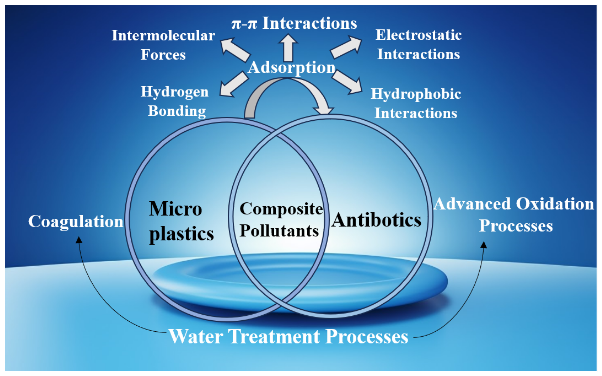 PDF(2104 KB)
PDF(2104 KB)


Interaction Between Microplastics and Antibiotics in Aquatic Environments and the Characteristics of Composite Pollution Removal by Coagulation and Advanced Oxidation Methods
Mianmo Li, Minghao Sui
Prog Chem ›› 2025, Vol. 37 ›› Issue (1) : 124-132.
 PDF(2104 KB)
PDF(2104 KB)
 PDF(2104 KB)
PDF(2104 KB)
Interaction Between Microplastics and Antibiotics in Aquatic Environments and the Characteristics of Composite Pollution Removal by Coagulation and Advanced Oxidation Methods
As public concern regarding the safety of drinking water continues growing, microplastics and antibiotics have emerged as new contaminants of interest within the field of water treatment. Microplastics and antibiotics not only pollute aquatic environments and endanger both aquatic life and human health, but their coexistence in water can also lead to physical and chemical interactions, such as adsorption. These interactions are influenced by various factors, including the morphology, functional groups, and aging degree of microplastics, as well as the pH, temperature, salinity, heavy metal ions, and organic macromolecules in the water. The resulting microplastic-antibiotic complex pollutants exhibit greater toxicity and are more challenging to remove. This review discusses the hazards of microplastics and antibiotics in water, their interaction mechanisms, and influencing factors. It also highlights the removal characteristics of complex pollutants using two typical water treatment technologies: coagulation and advanced oxidation. The principles and degradation effects of these treatment processes are analyzed in detail.
1 Introduction
2 Hazards of microplastic-antibiotic composite pollutants
3 Mechanisms of interaction between microplastics and antibiotics
4 Factors influencing the interaction between micro- plastics and antibiotics
5 Coagulation removal of microplastic-antibiotic composite pollution
6 Advanced oxidation degradation of microplastic- antibiotic composite pollution
7 Conclusion and outlook

microplastics / antibiotics / adsorption mechanisms / composite pollution / coagulation / advanced oxidation process
| [1] |
|
| [2] |
|
| [3] |
|
| [4] |
|
| [5] |
|
| [6] |
|
| [7] |
|
| [8] |
(唐抒圆, 吉林大学博士论文, 2023. )
|
| [9] |
|
| [10] |
|
| [11] |
(陆嘉玮, 东华大学博士论文, 2023. )
|
| [12] |
|
| [13] |
|
| [14] |
|
| [15] |
|
| [16] |
|
| [17] |
|
| [18] |
|
| [19] |
|
| [20] |
|
| [21] |
|
| [22] |
|
| [23] |
|
| [24] |
|
| [25] |
|
| [26] |
|
| [27] |
|
| [28] |
|
| [29] |
|
| [30] |
|
| [31] |
|
| [32] |
|
| [33] |
|
| [34] |
|
| [35] |
|
| [36] |
|
| [37] |
|
| [38] |
|
| [39] |
|
| [40] |
|
| [41] |
|
| [42] |
|
| [43] |
|
| [44] |
|
| [45] |
|
| [46] |
|
| [47] |
|
| [48] |
|
| [49] |
|
| [50] |
|
| [51] |
|
| [52] |
|
| [53] |
|
| [54] |
|
| [55] |
|
| [56] |
|
| [57] |
|
| [58] |
|
| [59] |
|
| [60] |
|
| [61] |
|
| [62] |
|
| [63] |
|
| [64] |
|
| [65] |
|
| [66] |
|
| [67] |
|
| [68] |
|
| [69] |
|
| [70] |
|
| [71] |
(姚晶晶, 中南大学博士论文, 2022.)
|
| [72] |
|
| [73] |
|
| [74] |
|
| [75] |
|
| [76] |
|
| [77] |
|
| [78] |
|
| [79] |
(韦采妮, 重庆交通大学硕士论文, 2023. )
|
| [80] |
|
/
| 〈 |
|
〉 |